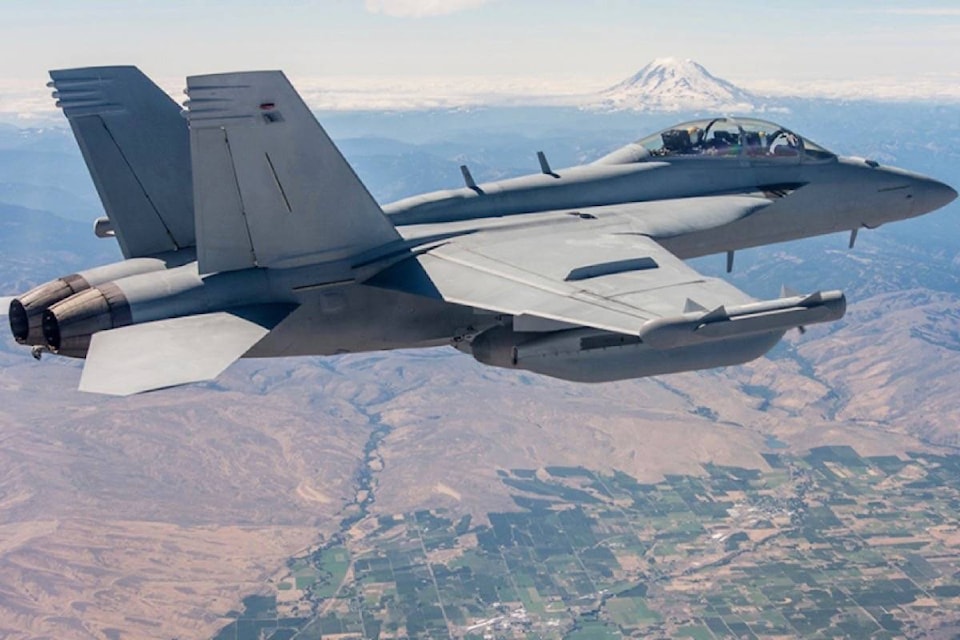With the Snowbirds jetting across the skies of Greater Victoria earlier this week, locals had their share of swoosh and swosh ringing above their heads.
Show’s not over though, as some residents in Saanich and Oak Bayreported hearing familiar jet rumblings coming from ongoing Growler operations State-side in recent days, seemingly louder than usual.
“On the long weekend, I found them to be not only numerous, but louder than I can recall,” said Oak Bay Mayor Nils Jensen, who, like other locals, feels the noise has escalated to almost painful decibel levels.
What is a Growler anyway?
No, it’s not a mythical monster that eats babies in the middle of the night. It’s a military aircraft, known as the EA-18G Growler (EA stands for electronic attack) a modified version of the F/A-18F Super Hornet fighter jet, designed for service on aircraft carriers. Like their technical name suggests, Growlers provide critical electronic intelligence, surveillance and reconnaissance data to other joint force aircraft around the world.
Today, the U.S. Naval Air Station on Whidbey Island – about 90 kilometers south-east across the water from Victoria – is home to 82 fully-operational Growlers, with another 36 planned to join the flock in the coming years.
Though not much has changed in terms of the aircraft’s design or overall training practices, noise emanating from Growlers can be impacted greatly by atmospheric conditions, said Mike Welding, Public Affairs Officer with the U.S. Navy.
“Different times of the year, depending on what’s happening in the atmosphere, the noise may carry further,” he said, noting the peak times when noise is likely heard or felt is during a known Growler operation called Field Carrier Landing Practice, described simply as close-in, repetitive training.
Typically, Welding said these practice sessions can go on for 45 minutes at a time, with a small break in-between, and maybe 15 minutes later, another group of Growlers go in. Naturally, the type of training is specific to the Growler’s intended purpose and design, notably aircraft carrier operations.
“That type of training is for fleet squadrons, which is tied to aircraft carrier deployment schedules,” he said, adding Growler pilots have to complete this training before they get underway on an aircraft carrier. “That’s what the training does, it prepares them to do that type of activity, which is a very challenging thing to do.”
Welding pointed out people may also hear the aircraft flying out to a military operating area over the Olympic Peninsula, and off the coast. Typically, but not always, the route over there is between Squim and Port Angeles.
“Generally, by the time they’re over the coast, they’re at 15,000 or 16,000 feet.”
Despite frustrations from Victoria, the U.S. Navy is trying to reduce the Growler’s noise output, mostly with technological tweaks to the aircraft. One such attempt was the installation of chevrons on the Growler’s exhaust nozzles, a device that decreased the noise slightly, but also had a degradation effect on the performance of the aircraft, which U.S. Navy brass deemed as “unacceptable.”
Ironically, the Growler is still quieter than its predecessor, the EA-6B Prowler, with at least 8 db lower. Growlers also climb away faster than Prowlers, reducing their noise footprint overall.
Still, the U.S. Navy didn’t give up on that just yet.
“They have not shelved that idea yet, they are looking at using the chevrons with different materials, so they’re still working on that,” Welding said.
Other strategies in reducing the Growler’s growl over local shores is the Magic Carpet, a software being implemented on all Growlers that will help pilots land the aircraft on aircraft carriers, potentially shortening their training schedules.
“If that bears fruit and pans out, that’s going to impact the operations that they conduct now. Will it reduce that, that’s all being studied as well,” Welding added.
As for the time being, not much can be done, other than monitoring the noise and continue reporting it, Jensen noted.
“It really is beyond our jurisdiction (municipally) to do anything about it, other than what people have done, and what I’ve done as to provide some feedback to the impact of the noise,” he said. “It’s a matter that the federal government would want to take up with them.”
Frustrated residents can also voice their noise concerns with Growlers via the NAS’s Whidbey Island automated comment line (1-360-257-6665).



